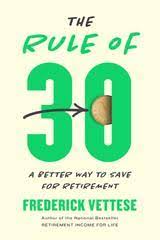
My latest MoneySense Retired Money column reviews actuary Fred Vettese’s new retirement book: The Rule of 30 (ECW Press).
You can find the full column by clicking on the highlighted headline here: What’s the Rule of 30? And what does it have to do with Income and Retirement?
Never heard of the Rule of 30? Neither had I, nor Fred himself until he invented it.
In a nutshell, it’s a rule of thumb financial planners can use to guestimate how much young couples starting off on their financial journeys need to save for Retirement. Rather than flatly state something like save 10 or 12 or 15% of your gross (pre tax) income each and every year, the Rule of 30 sees retirement saving as occurring in tandem to Daycare and Mortgage Repayment.
From the get go Vettese suggests young couples allocate 30% of their gross or after-tax income to the three expenses of Retirement saving, Daycare and Mortgage paydown. However, in the early years they may save less in order to handle Daycare and the mortgage. Since daycare expenses usually fall away after a few years (depending on how many children a couple has), once it has gone you can ramp up the mortgage paydown and/or retirement savings. And if – ideally five years before retirement – the home mortgage is paid off, then couples can kick their retirement saving into overdrive by allocating a full 30% or more solely to building their nest egg.
Wealthy Barber style fictional format
In a departure from his previous books — Retirement Income for Life and The Essential Retirement Guide among them — The Rule of 30 uses the tried-and-true quasi-fictional “story” pioneered by David Chilton’s The Wealthy Barber. That road has been ploughed by many subsequent financial authors, including Yours Truly in Findependence Day.
As Vettese told me in an interview mentioned in the column, he didn’t plan it that way initially. “I did a first chapter using that format and then realized it’s a lot easier to write this way and it’s not as dry: it’s somewhat easier to read and to write. When you get a problem, a character chimes in.”
The main characters are a couple, X and Y, and — conveniently — the neighbour next door who happens to be an actuary with time on his hands.
No doubt it would have worked either way, but Vettese’s dialogs are readable enough and he even works in a minor subplot involving the actuary and his estranged daughter.
One of the people acknowledged by Vettese at the back of the book is fellow actuary and retiree Malcolm Hamilton. In an email, Hamilton said “I have always believed that middle class Canadians who marry, buy a house and have children cannot reasonably expect to save much for retirement until after the age of 45,” Hamilton told me via email, “There just isn’t enough income to cover mortgage payments, the cost of raising children and Canada’s heavy tax burden (with child care expenses and mortgage payments generally non deductible for those with incomes that suggest they need to save.”
All in all, a useful rule of thumb for young couples setting out on family formation, home ownership and ultimately Retirement. Note that Vettese says that once you are within five years of your hoped-for Retirement age, you should strive to be mortgage free. And around 55, you should move from the Rule of 30 to using a Retirement calculator like the free one Vettese developed for Morneau Shepell: PERC, or the Personal Enhanced Retirement Calculator.
PS: I am now Investing Editor at Large for MoneySense
Alert readers who got to the bottom of the column and read the author blurb will see a slight change in my status at MoneySense. In addition to writing the monthly Retired Money column I am now also the Investing Editor at Large for the site, a fact that’s also divulged in my Twitter profile. I will continue to publish Hub blogs every business day: so much for Retirement!


